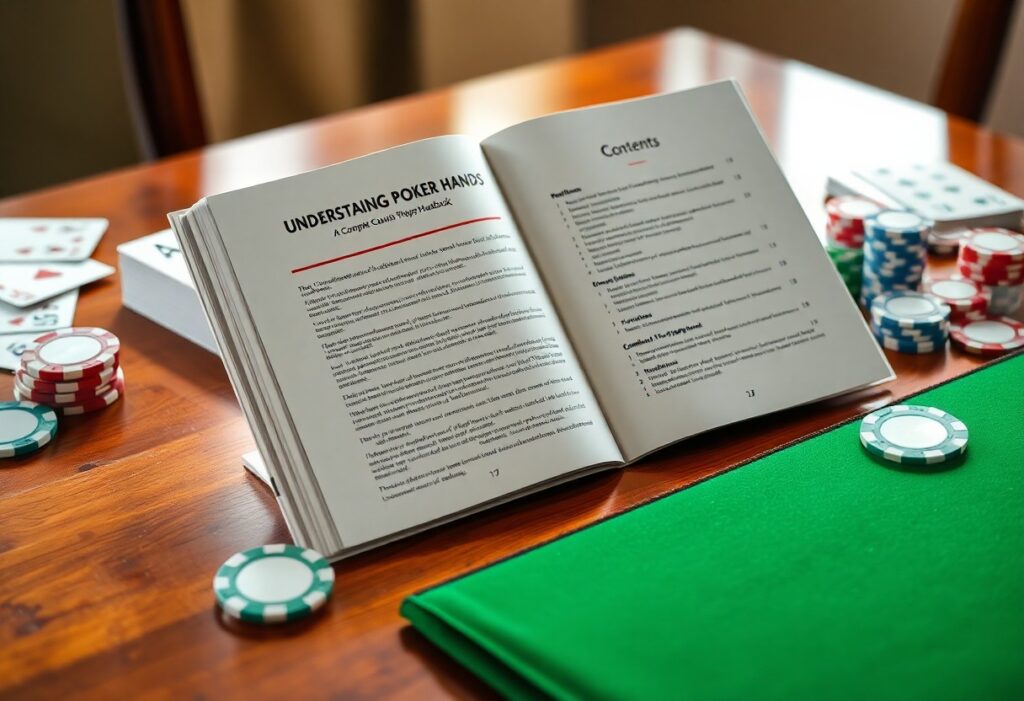
Casino enthusiasts must have a solid grasp of poker hands to navigate the thrilling world of this classic game. This guide examines into the intricacies of hand rankings, from the powerful royal flush to the modest high card, empowering players to make informed decisions. Understanding these fundamentals can enhance your gameplay and improve your chances of success at the table. Dive into this complete handbook to ensure you’re equipped with the knowledge needed to elevate your poker experience.
Types of Poker Hands
In poker, understanding the different types of hands is imperative for developing a winning strategy. The strength of a hand is determined by its composition and hierarchy in the game. Below are the primary categories:
- High Cards
- Pairs
- Three of a Kind
- Straights
- Flushes
- Full House
- Four of a Kind
- Straight Flush
After mastering these hand types, players can make informed decisions during gameplay.
High Cards
High cards refer to hands that contain no pairs, straights, or flushes, relying on the highest card value instead. The player with the highest card wins, making this a relatively weak hand in poker.
Pairs
A pair consists of two cards of the same rank, providing a stronger hand than high cards. It can dominate a range of other hands, especially if paired with a high kicker card.
For example, a pair of Aces (AA) is more favorable than a pair of Twos (22). Pairs form a critical foundation for many players and can often lead to more complex hands such as three of a kind or a full house.
Three of a Kind
Three of a Kind consists of three cards of the same rank, which significantly increases the hand’s strength compared to pairs. This hand can create additional playing options and tactics.
When you hold three cards of the same rank, it increases your chance of winning since it typically beats pairs and high cards. Moreover, players can use their additional cards as ‘kickers’ to enhance their hand further, providing strategic leverage during play.
Straights
Straights are hands that contain five consecutive cards, regardless of their suits. The highest card determines the strength of the straight. For example, a straight from 10 to Ace beats one from 5 to 9.
This hand can be versatile, creating opportunities for bluffing and aggressive betting. Its ranking is imperative as it can easily outplay pairs and three of a kind, but is susceptible to flushes and higher hands like a full house.
Flushes
Flushes consist of five cards of the same suit, not in sequence. The strength of the flush is determined by the highest card within the hand.
Flushes can prove advantageous in strategy since they often beat straights and high cards. However, they can be vulnerable to stronger hands like full houses and four of a kind. Players must assess their opponents wisely when holding this hand type.
Full House
A full house contains three of a kind and a pair, offering a dominating position in most poker scenarios due to its strength.
With a structure built on solid combinations, a full house can overpower many other hands, making it a favorite among players. It ranks above flushes and straights, enhancing the likelihood of winning. Lucky draws or well-timed bets can leverage a full house to great effect.
Four of a Kind
Four of a Kind consists of four cards of the same rank, which is a very strong hand. The fifth card serves as a kicker.
This hand is robust and rare, easily overpowering a full house or flush. The strategic use of a four of a kind can drive significant betting actions, as players often seek to capitalize on their strong position and potential opponent weaknesses.
Straight Flush
A straight flush includes five consecutive cards of the same suit, ranking it among the top hands in poker. It is both powerful and rare.
The rarity of a straight flush elevates its desirability, making it an outstanding hand to hold. In many games, it outmatches all other hands except for a royal flush, the highest possible hand. This combination can decisively influence rounds, so knowing when to bet aggressively is integral to maximizing its potential.
Royal Flush
Definition and Significance
A Royal Flush is the highest-ranking hand in poker, consisting of an Ace, King, Queen, Jack, and Ten, all of the same suit. This rare combination is so powerful that it beats all other hands, making it a player’s ultimate goal. Statistically, the chances of being dealt a Royal Flush are about 1 in 649,740, which emphasizes its prestige and desirability at the table. Players often celebrate this extraordinary hand, as holding one can dramatically shift the dynamics of a game and lead to substantial winnings.
Tips for Evaluating Hands
Assessing your poker hand is necessary for making informed decisions at the table. Focus on factors such as your hand’s strength compared to the board, the potential for drawing hands, and opponents’ actions.
- Hand strength in relation to community cards
- Potential draws that could improve your hand
- Opponent behavior for insight into their hand
Knowing multiple strategies enhances your ability to play effectively and maximize your winnings.
Understanding Hand Ranks
Familiarity with hand ranks is necessary to gauge the strength of your position. From the strongest Royal Flush to the weakest High Card, the ranking system dictates your strategies. Understanding these ranks influences the way you approach the game, helping you make decisions based on your current situation on the table.
Reading Opponents
Deciphering your opponents’ behaviors can provide valuable insights into their potential hand strength. Observing betting patterns, timing of bets, and physical tells is key to making educated guesses about what they hold. This information can help you adjust your strategy and improve your chances of success.
For instance, if an opponent consistently raises their bets when they have a strong hand, it may signal confidence in their cards. Alternatively, if another player is hesitant and takes time to play, they may be holding a weaker hand. Each player’s unique style adds depth to the game, supplying opportunities for those who pay close attention.
Effective Betting Strategies
Implementing effective betting strategies can significantly influence the outcome of any game. Employ techniques such as value betting to maximize profits on strong hands, or bluffing to pressure opponents. Carefully timed bets can manipulate the flow of the game and create favorable scenarios for you.
For example, utilizing a small bet when you hold a strong hand can lure opponents into the pot, enticing them to stay in with weaker cards. Conversely, using larger bets when bluffing can intimidate opponents, potentially forcing them to fold. Employing these strategies can give you an edge in competitive situations, allowing you to control the game’s pace and flow.
Step-by-Step Guide to Playing Poker
| Step | Description |
|---|---|
| Setting Up the Game | Gather players, determine the game type, and establish the rules and betting limits. |
| Placing Bets | Decide on initial bets, which can vary depending on the chosen poker variant. |
| Playing the Rounds | Take turns playing, showing hands, and reacting based on outcomes and player actions. |
| Knowing When to Fold | Evaluate your hand’s strength and potential before deciding to continue or fold. |
Setting Up the Game
To begin, all players should gather around a designated table, ensuring that everyone understands the chosen poker variant and its specific rules. Establish the betting limits clearly to avoid confusion later in the game. Properly shuffle and deal the cards according to the rules established while making certain everyone is aware of their position in the game.
Placing Bets
In each round, players will place their bets according to their hand strength and confidence. Initial bets can be blind bets or antes, depending on the game format. The betting structure can vary widely, from fixed limits in Texas Hold’em to no limits in games like Pot Limit Omaha.
It’s important for players to assess their hands and calculate risks when betting. A good strategy may involve looking at both the strength of one’s hand and the potential actions of other players. For instance, if your hand is strong but your position is late in the betting order, you might consider a more aggressive bet to force others to fold.
Playing the Rounds
Once the bets are placed, the game proceeds through several rounds where players will receive cards, and community cards may be dealt. Each turn allows players to either bet, check, call, raise, or fold based on their hand and analysis of opponents’ actions.
During each round, careful observation is vital. Pay attention to betting patterns and emotional signals from your opponents, which can provide insights into their hand strength. Keeping track of the community cards can greatly influence your strategy, as the game evolves with each round.
Knowing When to Fold
Deciding when to fold is necessary for preserving your chips and playing strategically. Strong hands can sometimes shift into weaker positions due to community cards; thus, recognizing when odds are against you is key. If you sense that your opponents are confident, especially after substantial betting, it may be wise to fold instead of risking further investment in a subpar hand.
Evaluating your own hand alongside the betting behavior of other players can offer significant insight. If your hand does not improve after the flop or turn and the betting escalates, folding might prevent further losses. Analyzing your position in relation to the community cards and remaining players will greatly enhance your decision-making process.
Factors Influencing Hand Strength
The strength of a poker hand is affected by multiple factors that can significantly alter the chances of winning. These factors include position at the table, number of players, and community cards. Understanding these elements allows players to make informed decisions when betting or folding. Assume that a player can enhance their winning potential by mastering these influences.
Position at the Table
Your position at the table is vital in determining how to play your hand. Players in early positions have limited information, whereas those in late positions can gauge their opponents’ actions before acting. Strong players exploit positional advantages by making bold moves when acting last or adopting conservative strategies when first to act.
Number of Players
The number of players in the game directly impacts hand strength. Fewer players generally mean higher quality hands are needed to win, while larger tables allow for a broader range of starting hands due to increased chances of chasing draws and bluffing opportunities.
In a full-ring game with ten players, the likelihood of weaker hands winning diminishes, making it crucial to play tighter. Conversely, in shorthanded situations, since there are fewer opponents, hands that may not typically be strong can become viable, increasing overall aggression and bluffing potential.
Community Cards
Community cards play a significant role in shaping the strength of a hand. They create possibilities for various combinations and draws. Players must evaluate how these shared cards interact with their hole cards to determine whether their hand has become stronger or remains vulnerable.
For instance, if the flop reveals two hearts and a spade, players holding a heart can aim for a flush. Conversely, those without a connection to the board need to be wary of opponents who could be drawing to strong hands. Understanding these dynamics is crucial for making tactical decisions throughout a hand.
Pros and Cons of Different Poker Hands
| Pros | Cons |
|---|---|
| High potential for winning pots. | Can be easily read by experienced players. |
| Stronger hands can intimidate opponents. | Vulnerability to counter-strategies. |
| Better equity against weaker hands. | Higher bets can attract aggressive players. |
| Encourages aggressive playstyle. | Requires careful management to avoid overcommitment. |
| Increases likelihood of bluffing success. | Losses can be more severe with higher stakes. |
| Strength can lead to larger pot sizes. | Limited versatility in hand play. |
| Favorable for tournament play. | May lead to predictable strategies. |
| Supports a powerful table image. | Can result in emotional bias if not managed. |
| Potential for big wins. | Can inspire fear-based folds from others. |
| Creates opportunities for strategic depth. | Risk of excessive focus on premium hands. |
Advantages of Strong Hands
Strong hands, such as a flush or full house, offer significant advantages in poker, including increased winning probabilities and the ability to dominate weaker hands. Their high equity during showdown scenarios allows players to extract maximum value and apply pressure on opponents. Moreover, consistently strong hands foster a more aggressive playing style that can intimidate other players, leading to folds that further solidify a player’s advantage.
Disadvantages and Risks
Despite their potential, strong hands come with notable risks. Players may overestimate their chances of winning, leading to overcommitting to pots that aren’t favorable. Furthermore, skilled opponents can exploit predictable patterns, making it easier to counter plays. This reliance on strong hands can also result in vulnerabilities against opportunistic players who capitalize on bluffs or weaker strategies, creating a delicate balance.
Continuing the discussion about disadvantages and risks, the danger lies in a player’s potential to become too emotionally attached to their strong hands, resulting in poor decision-making. For instance, an individual holding pocket aces might insist on going all-in, ignoring the board dynamics or the betting behavior of others. Such decisions can lead to significant losses when a seemingly weaker hand unexpectedly overcomes it, illustrating how even the strongest hands are not infallible in the unpredictable environment of poker.
Conclusion
The mastery of poker hands is important for any aspiring casino player, as it forms the foundation of successful gameplay. Understanding the hierarchy and nuances of each hand enhances strategic decision-making, increasing the likelihood of victory. Armed with this knowledge, players can navigate the complexities of the game with confidence and skill. A complete grasp of poker hands not only elevates one’s playing experience but also fosters a deeper appreciation for the art of poker.
FAQ
Q: What are the basic poker hands from highest to lowest?
A: The basic poker hands from highest to lowest are: 1. Royal Flush 2. Straight Flush 3. Four of a Kind 4. Full House 5. Flush 6. Straight 7. Three of a Kind 8. Two Pair 9. One Pair 10. High Card.
Q: How does a Straight differ from a Flush?
A: A Straight consists of five consecutive cards of different suits, while a Flush consists of any five cards of the same suit that are not in sequence. The rank of the cards determines the winning hand when comparing.
Q: What does it mean to have Two Pair in poker?
A: Two Pair refers to a hand that contains two cards of one rank, two cards of another rank, and one unrelated card. For example, having two Kings, two Tens, and a Four constitutes a Two Pair hand. The higher pair determines the strength of the hand in case of a tie.



